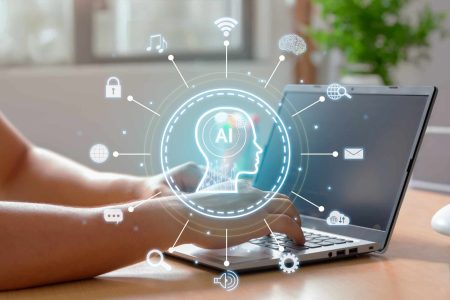In today’s fast-paced digital landscape, businesses are constantly seeking innovative ways to enhance customer service while managing costs effectively. AI chatbots have emerged as a powerful tool in this endeavor, revolutionizing the way companies interact with their customers. As AI technology continues to advance, its role in customer service is becoming increasingly pronounced, offering cost-effective solutions that promise to transform customer interactions. These intelligent systems not only reduce operational expenses but also significantly enhance the customer experience by providing instant, accurate responses. The scalability and efficiency benefits of AI chatbots allow businesses to handle increased customer inquiries without compromising service quality. When comparing AI chatbots to traditional customer service methods, the advantages become clear, highlighting the need for strategic implementation. However, embracing this technology requires careful consideration of challenges and best practices to ensure successful integration. As we look to the future, AI chatbots are poised to play an even more critical role in shaping customer service, making it essential for businesses to stay informed about emerging trends and developments.
Content
Introduction to AI Chatbots
Understanding AI Chatbots
AI chatbots are computer programs designed to simulate human conversation through voice commands, text chats, or both. These chatbots utilize artificial intelligence to interpret user inputs and respond intelligently, often mimicking human-like interactions. By leveraging natural language processing and machine learning, AI chatbots can understand context, recognize patterns, and improve over time. They are deployed across various platforms, including websites, messaging apps, and customer service portals, to assist users in real-time. Unlike traditional chatbots, which follow scripted interactions, AI chatbots can handle complex queries and provide personalized responses, making them a valuable asset for businesses looking to enhance customer engagement. Their ability to operate 24/7 ensures that customer inquiries are addressed promptly, improving overall customer satisfaction. As technology progresses, AI chatbots are becoming more sophisticated, capable of understanding nuanced language and delivering more accurate responses, thus playing a crucial role in modern customer service strategies.
The Evolution of Chatbot Technology
The journey of chatbot technology began with simple rule-based systems, which relied on pre-defined scripts to interact with users. These early chatbots were limited in scope, handling only basic queries and often failing to understand complex requests. However, advancements in artificial intelligence have transformed chatbots into sophisticated tools capable of learning and adapting to user behavior. The integration of machine learning and natural language processing has enabled chatbots to understand context, sentiment, and intent, allowing for more meaningful interactions. This evolution has been driven by the increasing demand for efficient customer service solutions and the need for businesses to engage with customers across multiple channels. As AI technology continues to advance, chatbots are becoming more intuitive and capable, offering personalized experiences that were once considered unattainable. This evolution reflects a broader trend towards automation and digital transformation in customer service, paving the way for more intelligent and responsive systems.
Benefits of Using AI Chatbots
AI chatbots offer numerous benefits that make them an attractive solution for modern businesses. One of the most significant advantages is their ability to provide round-the-clock customer support, ensuring that queries are addressed promptly, regardless of time zones or business hours. This continuous availability enhances customer satisfaction and loyalty, as users receive immediate assistance. Additionally, AI chatbots can handle a high volume of inquiries simultaneously, reducing the burden on human customer service agents and allowing them to focus on more complex issues. This scalability leads to increased efficiency and cost savings, as businesses can serve more customers without expanding their workforce. AI chatbots also offer personalized interactions by analyzing user data and preferences, providing tailored responses that improve the overall customer experience. As these systems continue to evolve, their ability to deliver accurate, context-aware assistance will further solidify their role as essential components of effective customer service strategies.
The Rise of AI in Customer Service
AI has dramatically transformed the landscape of customer service by automating routine tasks and enhancing customer interactions. The rise of AI in this field can be attributed to its ability to process vast amounts of data quickly and accurately, enabling businesses to deliver faster and more efficient service. AI-powered chatbots and virtual assistants are now commonplace, handling everything from basic inquiries to complex problem-solving. These technologies not only reduce wait times but also provide personalized experiences by analyzing customer data and preferences. As a result, businesses can offer tailored solutions that meet individual needs, leading to higher customer satisfaction and loyalty.
The increasing integration of AI in customer service is driven by the demand for seamless, 24/7 support. Customers today expect immediate responses and solutions, a need that AI is well-equipped to meet. By automating repetitive tasks and providing instant assistance, AI allows human agents to focus on more complex issues that require a personal touch. This shift not only improves the efficiency of customer service operations but also enhances the quality of interactions. Companies leveraging AI technology can maintain a competitive edge by offering superior service that meets the evolving expectations of their customers. As AI continues to evolve, its role in customer service is expected to expand, offering even more sophisticated solutions.
Furthermore, AI’s ability to learn and adapt over time is revolutionizing customer service strategies. Machine learning algorithms enable AI systems to continually improve their performance by analyzing interactions and feedback. This adaptability allows businesses to refine their customer service processes, ensuring they remain responsive to changing customer needs and preferences. AI can also predict customer behavior and identify potential issues before they arise, allowing for proactive service and problem resolution. By anticipating customer needs, businesses can create more meaningful and engaging experiences, fostering stronger relationships and encouraging brand loyalty. As AI technology advances, its potential to transform customer service will only grow, offering new opportunities for businesses to enhance their service offerings.
Cost-Effectiveness of AI Chatbots
Reducing Operational Costs
AI chatbots significantly reduce operational costs by automating routine customer service tasks that would otherwise require human intervention. By handling a large volume of inquiries simultaneously, chatbots decrease the need for a large customer service team, leading to savings in salaries, training, and infrastructure. This automation allows businesses to allocate resources more efficiently, focusing human efforts on complex issues that require personal attention. Additionally, AI chatbots operate 24/7 without the need for breaks or overtime pay, ensuring consistent service delivery without incurring additional costs. The scalability of chatbots also means that businesses can easily adjust to fluctuating demand without the financial burden of hiring temporary staff. As a result, companies can maintain high levels of customer service while significantly reducing their operational expenses, making AI chatbots a cost-effective solution for businesses of all sizes looking to optimize their customer service operations.
Enhancing Resource Allocation
AI chatbots enhance resource allocation by freeing up human agents to focus on more strategic tasks. By automating repetitive and time-consuming inquiries, chatbots allow customer service representatives to dedicate their skills to resolving complex issues that require human empathy and judgment. This shift not only improves the quality of customer service but also optimizes the use of human resources within the organization. Businesses can deploy their staff to areas where they can add the most value, such as personalized customer interactions, upselling, and cross-selling opportunities, or developing strategies for customer retention. This efficient allocation of resources leads to increased productivity and innovation, as employees are no longer bogged down by mundane tasks. AI chatbots thus enable businesses to maximize their human capital while maintaining high standards of customer service, contributing to a more agile and responsive organization that can adapt to changing market demands.
Long-Term Financial Benefits
The implementation of AI chatbots offers substantial long-term financial benefits that extend beyond immediate cost savings. By improving efficiency and customer satisfaction, chatbots contribute to increased customer retention and loyalty, which are crucial for sustained revenue growth. Satisfied customers are more likely to return and recommend the business to others, driving new sales and reducing the costs associated with acquiring new customers. Furthermore, chatbots provide valuable data insights that can inform business decisions and strategies, leading to more effective marketing campaigns and product development. This data-driven approach helps businesses identify trends, optimize their offerings, and stay ahead of the competition. Over time, the initial investment in AI chatbot technology pays off through enhanced customer experiences, reduced churn rates, and increased profitability. As AI technology continues to advance, these financial benefits are expected to grow, solidifying the role of chatbots as a strategic asset for businesses seeking long-term success.
Transform your business with custom AI solutions from a leading Artificial Intelligence Agency.
Enhancing Customer Experience with AI
AI chatbots play a crucial role in enhancing customer experience by providing instant and accurate responses to inquiries. Their ability to operate continuously without downtime ensures that customers receive support whenever they need it, regardless of time zones or business hours. This level of accessibility is increasingly important in today’s fast-paced world, where consumers expect immediate assistance. By reducing wait times and offering quick resolutions, AI chatbots improve customer satisfaction and foster a sense of trust and reliability. Furthermore, their capacity to handle multiple queries simultaneously means that customers experience fewer delays, even during peak times, leading to a more seamless and efficient service experience.
Personalization is another key aspect of how AI enhances customer experience. AI chatbots can analyze data from past interactions to tailor responses and recommendations to individual users. This personalized approach makes customers feel valued and understood, as the chatbot can offer solutions that are relevant to their specific needs and preferences. By remembering customer details and preferences, AI chatbots create a more engaging interaction that mimics a human touch. This level of personalization not only improves the quality of service but also strengthens customer loyalty, as users are more likely to return to a business that recognizes and caters to their unique requirements.
AI chatbots also contribute to a more consistent customer experience by maintaining a uniform tone and level of service across all interactions. Unlike human agents, who may vary in their approach, chatbots deliver standardized responses that align with the company’s brand and service standards. This consistency ensures that every customer receives the same high level of service, regardless of the channel or time of interaction. Additionally, AI chatbots can seamlessly integrate with other digital platforms, providing a cohesive experience across multiple touchpoints. This integration allows for a smoother transition between different stages of the customer journey, enhancing the overall experience and making it easier for customers to achieve their goals.
Experience effortless, cost-effective social media management with AI technologies
Scalability and Efficiency Benefits
Handling Increased Customer Volume
AI chatbots excel in managing increased customer volume without compromising service quality. Unlike human agents, chatbots can handle thousands of interactions simultaneously, ensuring that each customer receives immediate attention. This capability is particularly beneficial during peak times or promotional events when customer inquiries surge. By efficiently managing high volumes of requests, AI chatbots help businesses maintain consistent service levels and prevent bottlenecks that could lead to customer dissatisfaction. This scalability allows companies to expand their customer base and grow their operations without the need for proportional increases in staffing. As a result, businesses can achieve greater reach and responsiveness, ensuring that customer needs are met promptly and effectively. This capacity to scale effortlessly makes AI chatbots an invaluable tool for businesses looking to enhance their customer service operations while managing growth efficiently and sustainably.
Streamlining Workflow Processes
AI chatbots streamline workflow processes by automating routine tasks and inquiries, allowing human agents to focus on more complex issues. By handling repetitive questions and simple requests, chatbots free up valuable time for customer service representatives, enabling them to prioritize tasks that require human intervention and creativity. This streamlined approach enhances overall efficiency, as agents are not bogged down by mundane tasks and can contribute more effectively to strategic initiatives. Additionally, AI chatbots can integrate with existing systems and databases, providing instant access to information and resources that facilitate quicker resolutions. This integration reduces the need for manual data entry and retrieval, minimizing errors and speeding up service delivery. By optimizing workflow processes, AI chatbots improve the overall efficiency of customer service operations, allowing businesses to deliver faster and more accurate support to their customers.
Adapting to Business Growth
AI chatbots offer the flexibility needed to adapt to business growth and changing market demands. As companies expand, the ability to scale customer service operations quickly and efficiently becomes essential. AI chatbots provide this scalability by accommodating increased customer interactions without the need for significant infrastructure or staffing changes. This adaptability ensures that businesses can maintain high levels of service as they grow, avoiding potential disruptions or declines in customer satisfaction. Additionally, AI chatbots can be easily updated and customized to align with new products, services, or market trends, ensuring that customer support remains relevant and effective. This capability to evolve alongside the business allows companies to remain agile and responsive, meeting the needs of an expanding customer base while optimizing resources. By facilitating seamless growth, AI chatbots support businesses in achieving their long-term objectives and maintaining a competitive edge in the marketplace.
AI Chatbots vs. Traditional Customer Service
AI chatbots and traditional customer service differ significantly in their approach to handling customer inquiries. AI chatbots offer the advantage of instant response times, providing immediate assistance to customers without the need for human intervention. This immediacy is crucial in today’s fast-paced environment, where consumers expect quick resolutions to their issues. In contrast, traditional customer service often involves wait times, especially during peak hours, as human agents manage multiple requests. This delay can lead to customer frustration and decreased satisfaction. AI chatbots mitigate this issue by efficiently managing high volumes of inquiries simultaneously, ensuring that each customer receives prompt attention and support.
Another key difference lies in the consistency of service delivery. AI chatbots provide uniform responses that adhere to predefined guidelines and company standards, ensuring a consistent customer experience across all interactions. This consistency helps maintain brand integrity and customer trust, as users receive the same level of service regardless of when or how they contact the company. Traditional customer service, while offering a personal touch, can vary in quality depending on the agent’s experience, mood, or workload. This variability can lead to inconsistencies in customer experience, potentially affecting customer loyalty. AI chatbots eliminate these discrepancies, providing a reliable and standardized service that meets customer expectations every time.
However, traditional customer service excels in areas where human empathy and judgment are essential. Complex issues or emotionally charged situations often require the nuanced understanding that only a human agent can provide. While AI chatbots are continually improving in their ability to understand context and sentiment, they still lack the emotional intelligence and adaptability of human agents. As a result, a hybrid approach that combines the efficiency of AI chatbots with the empathy of human agents can offer the best of both worlds. By allowing chatbots to handle routine inquiries and freeing up human agents to focus on complex cases, businesses can optimize their customer service operations, delivering both efficiency and personalized care.
Elevate your business with DIGITALON AI’s custom AI services and solutions.
Implementing AI Chatbots: Best Practices
Defining Clear Objectives
When implementing AI chatbots, it is crucial to define clear objectives that align with your business goals. Understanding what you aim to achieve with the chatbot—whether it’s improving customer service efficiency, reducing operational costs, or enhancing customer engagement—will guide the development and deployment process. Clear objectives help in designing a chatbot that meets specific needs and delivers measurable results. Businesses should conduct a thorough analysis of customer interactions to identify common queries and pain points that the chatbot can address. This analysis ensures that the chatbot is equipped to handle relevant tasks and provides value to both the company and its customers. Additionally, setting performance metrics and key performance indicators (KPIs) from the outset allows businesses to evaluate the chatbot’s effectiveness over time, making necessary adjustments to optimize its performance and ensure it continues to meet the evolving needs of the business and its customers.
Ensuring Seamless Integration
Seamless integration with existing systems is essential for the successful implementation of AI chatbots. To maximize their effectiveness, chatbots should be able to access and utilize data from various sources, such as customer relationship management (CRM) systems, databases, and communication platforms. This integration enables the chatbot to provide accurate and context-aware responses, enhancing the overall customer experience. Businesses should work closely with IT teams to ensure that the chatbot is compatible with existing infrastructure and can easily exchange information across different systems. Additionally, integrating the chatbot with multiple communication channels, such as websites, mobile apps, and social media, ensures a consistent customer experience across all touchpoints. This multi-channel approach allows customers to interact with the chatbot through their preferred platforms, increasing accessibility and engagement. By ensuring seamless integration, businesses can leverage the full potential of AI chatbots, delivering efficient and personalized customer service.
Continuous Monitoring and Improvement
Continuous monitoring and improvement are vital components of implementing AI chatbots effectively. Once deployed, chatbots should be regularly monitored to assess their performance and identify areas for enhancement. Businesses can gather valuable insights by analyzing chatbot interactions, user feedback, and performance metrics, such as response accuracy and customer satisfaction scores. These insights help identify any shortcomings or issues that need to be addressed to improve the chatbot’s functionality. Additionally, as customer needs and preferences evolve, businesses should update the chatbot’s capabilities to ensure it remains relevant and effective. Regularly updating the chatbot’s knowledge base and incorporating new features or integrations can enhance its performance and keep it aligned with business objectives. By committing to continuous monitoring and improvement, businesses can ensure that their AI chatbots remain a valuable asset, consistently delivering high-quality customer service and adapting to changing market demands.
Challenges and Considerations
Implementing AI chatbots comes with several challenges that businesses must navigate to ensure success. One major challenge is the initial setup and integration with existing systems. This process can be complex, requiring significant time and resources to ensure that the chatbot functions seamlessly within the current technological infrastructure. Businesses must also ensure data compatibility and security, as chatbots often access sensitive customer information. Protecting this data from potential breaches is crucial, requiring robust security measures and compliance with relevant regulations. Additionally, the integration process may require collaboration between various departments, such as IT, customer service, and marketing, to align the chatbot’s functionality with organizational goals.
Another consideration is maintaining the quality and accuracy of the chatbot’s responses. While AI chatbots are designed to provide quick and efficient service, they may struggle with understanding nuanced language or complex queries. This limitation can lead to customer frustration if the chatbot fails to resolve issues effectively. To mitigate this, businesses should invest in ongoing training and development of the chatbot’s natural language processing capabilities. Regular updates to the chatbot’s knowledge base are essential to ensure it remains informed about new products, services, and customer inquiries. Additionally, providing a smooth transition to human agents for more complex issues can enhance customer satisfaction and ensure that users receive the support they need.
User acceptance and experience also play a critical role in the successful implementation of AI chatbots. Customers may be hesitant to interact with chatbots due to concerns about accuracy or preference for human interaction. To address this, businesses should focus on designing user-friendly interfaces that make it easy for customers to engage with the chatbot. Clear communication about the chatbot’s capabilities and limitations can help manage customer expectations and build trust. Additionally, businesses should actively seek feedback from users to identify areas for improvement and ensure the chatbot meets their needs. By prioritizing user experience and addressing potential concerns, businesses can increase acceptance and adoption of AI chatbots, ultimately enhancing their effectiveness as a customer service tool.
Future Trends in AI Chatbots
Advancements in Natural Language Processing
Future trends in AI chatbots are heavily influenced by advancements in natural language processing (NLP). As NLP technology evolves, chatbots are becoming more adept at understanding and interpreting human language, including nuances, slang, and regional dialects. This improvement allows chatbots to engage in more natural and meaningful conversations, enhancing the user experience. Enhanced NLP capabilities also enable chatbots to better understand context and sentiment, allowing them to provide more accurate and personalized responses. As these technologies continue to develop, we can expect AI chatbots to handle increasingly complex interactions with greater precision. This progress will make chatbots more versatile and effective across various industries, from customer service to healthcare and beyond. Businesses leveraging these advancements will be able to offer more sophisticated and human-like interactions, meeting the growing expectations of consumers for seamless and intuitive digital experiences.
Integration with Emerging Technologies
The integration of AI chatbots with emerging technologies is set to redefine their capabilities and applications. As technologies like the Internet of Things (IoT), augmented reality (AR), and virtual reality (VR) become more prevalent, chatbots will increasingly interact with these systems to provide enriched user experiences. For instance, chatbots integrated with IoT devices can offer real-time support and automation in smart homes and connected environments. In AR and VR settings, chatbots can serve as virtual assistants, guiding users through immersive experiences and offering contextual assistance. Additionally, the integration with voice-activated systems and smart speakers will further expand the accessibility and functionality of chatbots, allowing users to interact with them through voice commands seamlessly. These integrations will not only enhance the versatility of chatbots but also open new avenues for businesses to engage with customers, offering innovative solutions that blend digital and physical interactions.
Focus on Emotional Intelligence
As AI chatbots become more advanced, there is a growing focus on developing their emotional intelligence to enhance user interactions. Emotional intelligence in chatbots involves the ability to recognize, interpret, and respond appropriately to human emotions. By incorporating sentiment analysis and machine learning algorithms, future chatbots will be able to detect emotional cues from text or voice inputs and adjust their responses accordingly. This capability will allow chatbots to provide more empathetic and supportive interactions, especially in customer service scenarios where understanding and addressing user emotions are crucial. Improved emotional intelligence can lead to higher customer satisfaction and loyalty, as users feel more understood and valued. As research and development in this area progress, businesses will be able to deploy chatbots that not only solve problems efficiently but also build stronger emotional connections with their customers, creating a more personalized and human-like experience.
Conclusion and Key Takeaways
AI chatbots have emerged as a transformative force in customer service, offering a range of benefits that enhance efficiency, scalability, and customer satisfaction. Their ability to handle high volumes of inquiries simultaneously and provide instant responses makes them an invaluable asset for businesses looking to optimize their operations. By automating routine tasks, chatbots free up human agents to focus on complex issues, improving resource allocation and overall service quality. This shift not only reduces operational costs but also allows businesses to scale their customer service efforts in line with growth, ensuring consistent and reliable support for their expanding customer base.
Despite the numerous advantages, implementing AI chatbots presents challenges that require careful consideration. Businesses must address integration complexities, maintain data security, and ensure the chatbot’s responses are accurate and relevant. Additionally, fostering user acceptance is crucial, as customers may initially be hesitant to interact with automated systems. By focusing on user-friendly design and clear communication about the chatbot’s capabilities, businesses can build trust and encourage adoption. Continuous monitoring and improvement are essential to keeping chatbots effective and aligned with evolving customer needs, ensuring they remain a valuable component of the customer service strategy.
Looking ahead, the future of AI chatbots is promising, with advancements in natural language processing, integration with emerging technologies, and enhanced emotional intelligence on the horizon. These developments will enable chatbots to provide more sophisticated and personalized interactions, further blurring the line between human and machine communication. Businesses that embrace these trends will be well-positioned to deliver exceptional customer experiences, fostering loyalty and differentiation in a competitive marketplace. By staying informed about the latest innovations and adopting a strategic approach to implementation, companies can harness the full potential of AI chatbots, driving long-term success and customer satisfaction.























